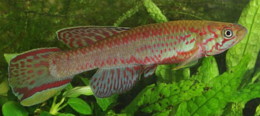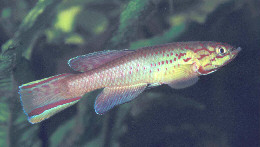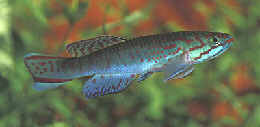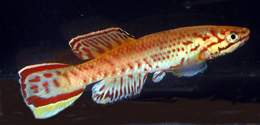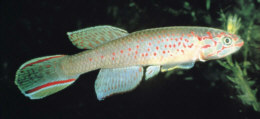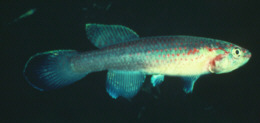Callopanchax monroviae (Roloff & Ladiges 1972)
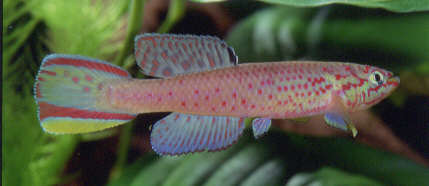
Callopanchax monroviae. Photo courtesy of Ed Pürzl
| Meaning of Name |
After the city of Monrovia, Liberia. |
|||||||||||||||||||||||||||||||||||||||||||||||||||||||||||||||||
| First Description |
Roloff, E. and W. Ladiges 1972 Roloffia monroviae spec. nov. Beschreibung einer reuen Roloffia-Art aus Liberia. Aquarien und Terrarien-Zeitschrift v. 25 (no. 9): 299-301. |
|||||||||||||||||||||||||||||||||||||||||||||||||||||||||||||||||
| Size |
8 cm |
|||||||||||||||||||||||||||||||||||||||||||||||||||||||||||||||||
| Meristics |
D=15·8, A=18·2, D/A=2, ll=33·8 |
|||||||||||||||||||||||||||||||||||||||||||||||||||||||||||||||||
| Karyotype |
n=23 |
|||||||||||||||||||||||||||||||||||||||||||||||||||||||||||||||||
| Sub-Genus | ||||||||||||||||||||||||||||||||||||||||||||||||||||||||||||||||||
| Group | ||||||||||||||||||||||||||||||||||||||||||||||||||||||||||||||||||
| Synonyms |
|
|||||||||||||||||||||||||||||||||||||||||||||||||||||||||||||||||
Populations
|
Harbel - Also distributed as 'Harbel Red'. Collected by Etzel & Putz but I have no information on the year of collection. Monrovia - Roloff collected in this area in 1972 & Etzel also collected here in 1978. |
|||||||||||||||||||||||||||||||||||||||||||||||||||||||||||||||||
| Type Locality |
Forest pool about 25 miles from Monrovia. |
|||||||||||||||||||||||||||||||||||||||||||||||||||||||||||||||||
| Distribution |
|
|||||||||||||||||||||||||||||||||||||||||||||||||||||||||||||||||
| Habitat |
This chart appeared in BKA newsletter No.100, December 1973 in an article by Hans van Es from data supplied by Ton van der Velde in 1972. It concerns the rainfall & temperatures over a 12 month period in the area of Monrovia.
Call.monroviae
is found sympatrically with Scriptaphyosemion
liberiense (then referred in the article as Roloffia
calabarica). |
|||||||||||||||||||||||||||||||||||||||||||||||||||||||||||||||||
| Distinguishing Characteristics | ||||||||||||||||||||||||||||||||||||||||||||||||||||||||||||||||||
| Colour/Pattern Variability | ||||||||||||||||||||||||||||||||||||||||||||||||||||||||||||||||||
| History |
Introduced into the KFN around 1970 as an import
from Peter Busink. At first these were considered to be Roloffia
occidentalis but a difference in colour patterns was later
used as a seperator between these sp. First introduced to the BKA through Fred Wright towards the end of 1972. A blue population was distributed in the BKA to breeders team members in October 1973. Red, Blue & yellow forms were imported into the USA but it seemed only the blue form could be found in year 2000. |
|||||||||||||||||||||||||||||||||||||||||||||||||||||||||||||||||
| Breeding Notes |
Fred Wright reported that eggs first received in the BKA hatched out after 5 and a half months of dry storage. A breeding report from BKA newsletter No.100
stated that fish were kept in a community of other large killies endemic
to west Africa. When females were ready for spawning they were placed
in a tank at least 24" long with a peat substrate of at least 2".
Plants were added as cover for females. Water conditions were regarded
as not critical & even wild fish were tolerant in this regard. Trios
were used for spawning. Fighting may ensue & can lead to the death
of either sex. Fish are left in this set up for a week & then taken
out. The peat was then taken out & dry stored for 12 weeks. The
peat was wet in water at the same temperature used for breeding. Fry
hatched rapidly & growth rate was regarded as very good. |
|||||||||||||||||||||||||||||||||||||||||||||||||||||||||||||||||
| Diameter of Egg | ||||||||||||||||||||||||||||||||||||||||||||||||||||||||||||||||||
| Remarks |
This sp. is regarded as a heavy eater. When fully bloated they later resume normal body proportions but have been observed not to eat again for some time. |
